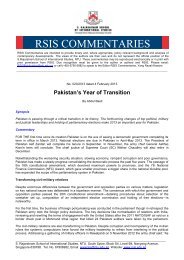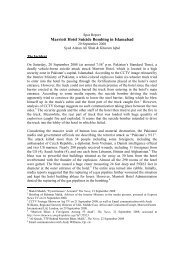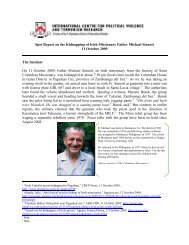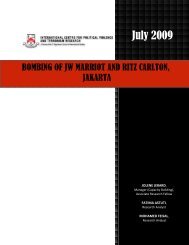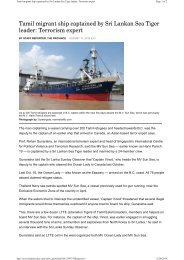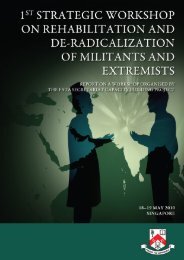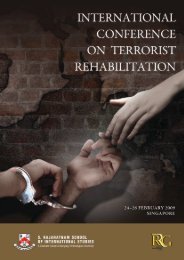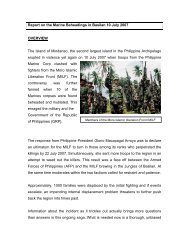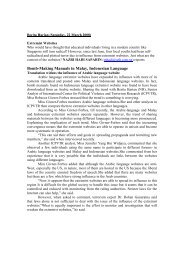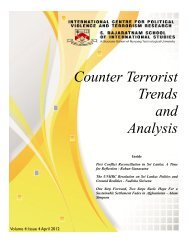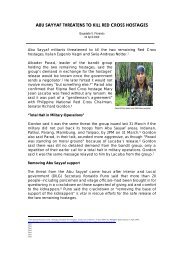Peace and Security Review, Vol.1 No. 2 - International Centre for ...
Peace and Security Review, Vol.1 No. 2 - International Centre for ...
Peace and Security Review, Vol.1 No. 2 - International Centre for ...
You also want an ePaper? Increase the reach of your titles
YUMPU automatically turns print PDFs into web optimized ePapers that Google loves.
50 <strong>Peace</strong> <strong>and</strong> <strong>Security</strong> <strong>Review</strong> <strong>Vol.1</strong>, <strong>No</strong>.2, Second Quarter, 2008<br />
ferry Inter-Isl<strong>and</strong> sea vessel in the off shore of Manila in 2003 3 <strong>and</strong> the Davao<br />
City international airport Bombing in 2003 4 that resulted to hundred of<br />
civilian casualties.<br />
These acts of terrorism bring to the general awareness of the public about<br />
the evolution of the Southern Philippines based secessionist threat. From<br />
what used to be a ethno-Islamist liberation struggle, it evolved into a radical<br />
Islamist movement, with global influence especially from the Middle East.<br />
The threat challenged the efficacy of the national security infrastructure of<br />
Philippine government <strong>and</strong> demonstrated a major flaw in the coordination of<br />
ef<strong>for</strong>ts among Philippines public institutions. A case in point is the problem<br />
of achieving unity of ef<strong>for</strong>ts of intelligence agencies such as those of the military<br />
<strong>and</strong> police in synchronizing operations to predict <strong>and</strong> prevent terrorist attack.<br />
The Philippine experience of deadly terrorist attacks made it a good subject<br />
of counter insurgency <strong>and</strong> counter-terrorism studies. Hence, this paper seeks<br />
to underst<strong>and</strong> the Philippine counter terrorism response. It generally looked<br />
into the question on why Philippines has not contained the nearly half a<br />
century Bangsamoro secessionist movement? The paper postulates that an<br />
absence of a comprehensive strategy <strong>and</strong> plan will lead to an inadequate, <strong>and</strong><br />
perhaps unsuccessful, counter insurgency <strong>and</strong> counter terrorism campaign.<br />
To answer this question, this paper examines, assesses, <strong>and</strong> analyzes the<br />
Philippine Counter Terrorism response to the Bangsamoro secessionist<br />
movement. It identifies counter-insurgency <strong>and</strong> counter-terrorism lessons<br />
learned <strong>and</strong> determine suitable policy recommendations needed.<br />
II. THE BANGSAMORO ARMED STRUGGLE IN SOUTHERN<br />
PHILIPPINES<br />
In order to underst<strong>and</strong> the Islamist inspired Terrorism in the Philippines, it is<br />
important to appreciate the Bangsamoro Secessionist struggle, its historical<br />
perspective, context <strong>and</strong> factors that affect its evolution. In doing so, this will<br />
help to identify inconsistency <strong>and</strong> inappropriateness of response of the<br />
Philippine government.<br />
The Evolution of the Moro Secessionist Movement<br />
This underst<strong>and</strong>ing could mirror the evolution that can best be described in<br />
at least three waves. The first wave is “Islamization,” which came by way of<br />
3 Colonel Juanito Dalmas, Director <strong>for</strong> Operations, ATTF, “Anti-terrorism Task Force Briefing<br />
(ATTF),” 2004.<br />
4 Ibid.<br />
<strong>Vol.1</strong>, <strong>No</strong>.2 2008 pp.49-76




